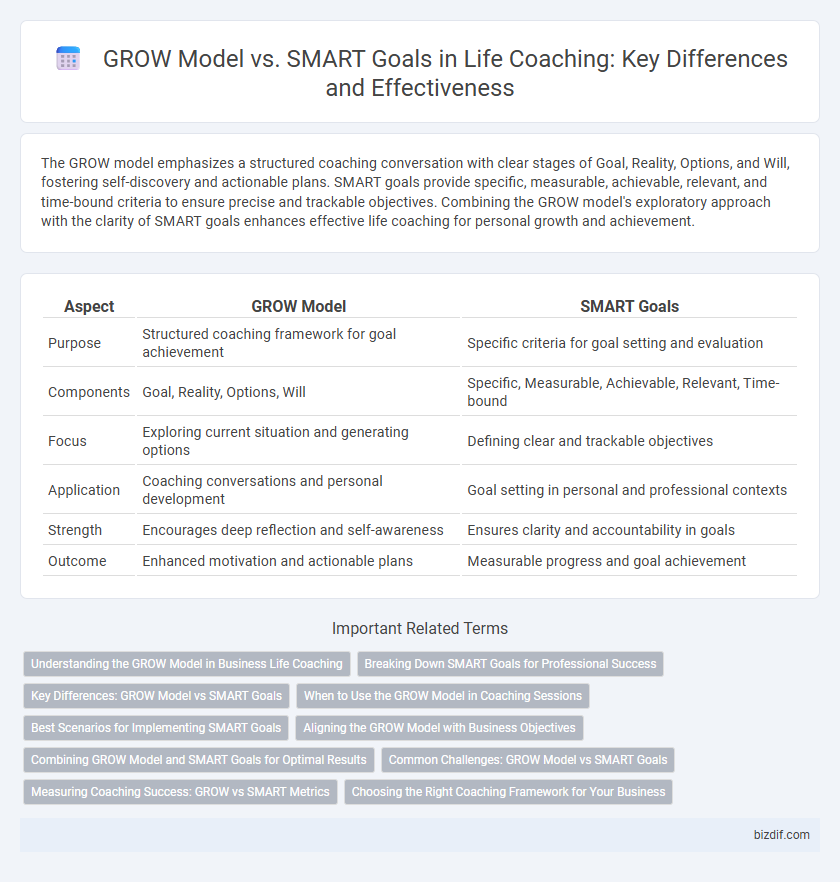The GROW model emphasizes a structured coaching conversation with clear stages of Goal, Reality, Options, and Will, fostering self-discovery and actionable plans. SMART goals provide specific, measurable, achievable, relevant, and time-bound criteria to ensure precise and trackable objectives. Combining the GROW model's exploratory approach with the clarity of SMART goals enhances effective life coaching for personal growth and achievement.
Table of Comparison
| Aspect | GROW Model | SMART Goals |
|---|---|---|
| Purpose | Structured coaching framework for goal achievement | Specific criteria for goal setting and evaluation |
| Components | Goal, Reality, Options, Will | Specific, Measurable, Achievable, Relevant, Time-bound |
| Focus | Exploring current situation and generating options | Defining clear and trackable objectives |
| Application | Coaching conversations and personal development | Goal setting in personal and professional contexts |
| Strength | Encourages deep reflection and self-awareness | Ensures clarity and accountability in goals |
| Outcome | Enhanced motivation and actionable plans | Measurable progress and goal achievement |
Understanding the GROW Model in Business Life Coaching
The GROW model in business life coaching provides a structured framework for goal-setting by guiding clients through four stages: Goal, Reality, Options, and Will, which enhances clarity and actionable planning. Unlike SMART goals that emphasize Specific, Measurable, Achievable, Relevant, and Time-bound objectives, the GROW model fosters deeper self-awareness and decision-making by exploring current realities and generating multiple options. This approach is effective in business coaching for developing personalized strategies that drive sustainable performance and accountability.
Breaking Down SMART Goals for Professional Success
Breaking down SMART goals into Specific, Measurable, Achievable, Relevant, and Time-bound elements provides a clear framework for professional success, ensuring objectives are well-defined and trackable. The GROW model emphasizes guided reflection through Goal, Reality, Options, and Will, fostering deeper self-awareness and actionable plans. Integrating SMART criteria within the GROW process enhances goal clarity and commitment, driving effective outcomes in life coaching sessions.
Key Differences: GROW Model vs SMART Goals
The GROW model emphasizes a conversational framework that guides clients through Goals, Reality, Options, and Will to foster self-discovery and actionable planning in life coaching. In contrast, SMART goals prioritize creating Specific, Measurable, Achievable, Relevant, and Time-bound objectives to clearly define and track progress. While the GROW model facilitates broad exploration and motivation, SMART goals provide structured criteria for setting and achieving concrete outcomes.
When to Use the GROW Model in Coaching Sessions
Use the GROW model in coaching sessions when exploring broad challenges or facilitating self-discovery and problem-solving in clients. It excels in guiding structured conversations through Goal, Reality, Options, and Will phases to enhance clarity and motivation. This model outperforms SMART goals when the focus requires deeper insight and adaptive strategies rather than fixed, measurable outcomes.
Best Scenarios for Implementing SMART Goals
SMART goals excel in scenarios requiring clear, measurable, and time-bound objectives, making them ideal for individuals seeking structured progress tracking and accountability. This framework thrives in performance-driven environments such as career development, project management, and habit formation, where specific milestones enhance motivation. Implementing SMART goals delivers precise direction and tangible results, ensuring effective life coaching outcomes when clients need clarity and focus.
Aligning the GROW Model with Business Objectives
Aligning the GROW model with business objectives enhances strategic clarity by integrating goal-setting with actionable steps, ensuring measurable progress in leadership development and team performance. While SMART goals define Specific, Measurable, Achievable, Relevant, and Time-bound targets, the GROW model--Goal, Reality, Options, Will--facilitates a dynamic coaching framework that uncovers obstacles and drives commitment. This synergy empowers businesses to translate high-level objectives into practical coaching outcomes that foster accountability and sustainable growth.
Combining GROW Model and SMART Goals for Optimal Results
Combining the GROW model and SMART goals enhances life coaching by integrating structured problem-solving with clear, measurable objectives, ensuring actionable progress and accountability. The GROW model's focus on Goal, Reality, Options, and Will complements SMART goals' Specific, Measurable, Achievable, Relevant, and Time-bound criteria to create a robust framework that supports client clarity and motivation. Utilizing both techniques together enables coaches to guide clients through reflective exploration while setting precise targets that drive sustainable personal and professional growth.
Common Challenges: GROW Model vs SMART Goals
The GROW model often faces challenges in maintaining focus during open-ended coaching sessions, while SMART goals can struggle with flexibility and adaptability in dynamic situations. Both approaches require careful alignment to the coachee's evolving needs to prevent miscommunication or stalled progress. Navigating these challenges involves balancing the structured specificity of SMART goals with the reflective, exploratory nature of the GROW model.
Measuring Coaching Success: GROW vs SMART Metrics
The GROW model enhances coaching success by structuring goal-setting through Goal, Reality, Options, and Will, enabling personalized progress tracking and reflection. SMART goals emphasize Specific, Measurable, Achievable, Relevant, and Time-bound criteria, offering clear quantitative metrics for evaluating outcomes. Measuring coaching success effectively integrates GROW's qualitative insights with SMART's objective benchmarks to optimize client development and accountability.
Choosing the Right Coaching Framework for Your Business
The GROW model emphasizes structured conversations through Goal, Reality, Options, and Will, fostering clarity and actionable steps in coaching sessions. SMART goals prioritize setting Specific, Measurable, Achievable, Relevant, and Time-bound objectives, ensuring precise and trackable outcomes. Selecting the right coaching framework depends on your business needs: use GROW for exploratory dialogue and decision-making, while SMART goals suit environments requiring concrete performance targets and accountability.
GROW model vs SMART goals Infographic

 bizdif.com
bizdif.com